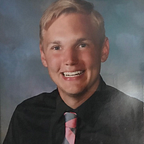The Importance of the 2020 Season for Sam Darnold
Why this could be a make-or-break year for the young QB
After the 2017 Rose Bowl, expectations started to grow for quarterback Sam Darnold. He had just shined in a win against the fifth ranked Penn State Nittany Lions, finishing the game with 453 passing yards and five touchdowns. While Darnold already had some expectations before the Rose Bowl (he was a four star recruit coming out of high school), he was about to face something far greater. The next season Darnold entered as the favorite for the Heisman trophy, and a presumptive lock for the first overall pick in the NFL draft. That season Darnold did not win the Heisman, nor did he live up to his lofty expectations. That doesn’t mean he had a bad season by any means (he finished with over 4,100 passing yards and 26 touchdowns to go with 13 interceptions), he just didn’t have the season everyone was expecting. Darnold decided to enter the NFL draft after the 2017 season, and despite some flaws, was still presumed to be the top choice. However he fell to the third pick where the New York Jets selected him.
Fast forward to 2020. Darnold has shown flashes of being a franchise quarterback. He has also showed growing pains as well. That is to be expected considering everything Darnold has had to overcome during his tenure with the Jets. After becoming the youngest opening-day quarterback in NFL history (21 years, 97 days), Darnold finished the 2018 season with 2,865 yards, and 17 touchdowns along with 15 interceptions in 13 games played. Those numbers don’t really scream franchise quarterback. However, if you look deeper, the Jets did not offer their QB much help. New York’s offensive line ranked dead last in run blocking (32nd), and 18th in pass blocking according to Football Outsiders. That season the Jets’ leading rusher was Isaiah Crowell with 685 yards, and their leading receiver was Robby Anderson with 752 yards. Not exactly the help you want to give your rookie quarterback.
The next season, New York hired new head coach Adam Gase. Despite having to learn a new playbook, and contracting Mono which sidelined him for three games, Darnold managed to show some improvement. He finished the year with 3,024 yards, 19 touchdowns and 13 interceptions in 13 games played. Still not franchise QB numbers, but much like 2018, the Jets didn’t offer much help. Their offensive line finished second to last in run blocking (31st), and third to last in pass blocking (30th). The splash signing of Le’Veon Bell didn’t work out as he finished the season with just 789 rushing yards. Darnold also was void of a thousand yard receiver again, as the leading receiver on the team was Jamison Crowder with 833 yards. Once again, the Jets failed to give Darnold the necessary resources to perform at a high level.
Now Darnold isn’t free of all the blame. No matter how bad his offensive line and weapons are, he has to cut down on the turnovers. In two seasons, Darnold has 33 total turnovers. That’s not going to cut it in the NFL. But the flashes of talent are there.
Last season, despite all the turmoil, the Jets had a winning record in games Darnold started. The USC quarterback also has had stretches of brilliance. According to Pro Football Focus, during weeks 10–13 of last season, Darnold had the third highest grade among all QBs in the NFL. That’s not all though. Darnold also had the highest grade of any QB when it came to clean pocket grade and uncatchable pass rate during weeks 14–17 of the 2018 season according to PFF. If Darnold has time to throw, he’s one of the best in the business. It now comes down to whether the Jets will give him a better supporting cast; and whether or not Darnold can build on consistency, instead of just having flashes.
That is why this upcoming season is so important for the third year quarterback. New general manager Joe Douglas made moves this offseason with Darnold solely in mind. Douglas signed three new offensive linemen (George Fant, Greg Van Roten, and Conor McGovern), along with using the 11th overall pick in the draft on Louisville tackle Mekhi Becton. It’s very likely that New York’s o-line has four new starters this upcoming season. While these players aren’t necessarily game changers up front, it’s hard to be much worse than the line last season. Douglas wasn’t done there however. After losing Robby Anderson in free agency, he signed Breshad Perriman, who is coming off the best season of his career. Douglas then used his second round pick on skilled Baylor receiver Denzel Mims. Both Perriman and Mims give Darnold big, fast options on the outside. New York also should get tight end Chris Herndon back. After a promising rookie campaign in 2018, Herndon dealt with injury and suspension much of 2019.
Getting Herndon back, along with two new receivers and four new offensive linemen puts the onus on Darnold this season. No more excuses. The new line should help the QB in pass protection, and in the play action game. Le’Veon Bell should have more space to work, which will only benefit Darnold. It’s now the quarterback’s time to shine.
So 2020 season will go one of two ways. Either the improvements will be enough for Darnold to finally show he’s a franchise quarterback. Or, the Jets will be forced to start thinking about whether or not they want to pick up the QB’s fifth year option in 2022. Darnold has a lot riding on the line. Will he be able to live up to expectations this time?
